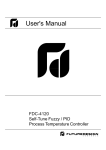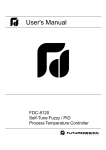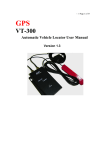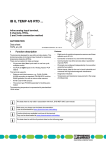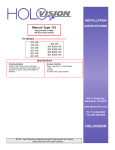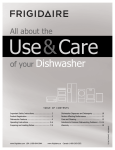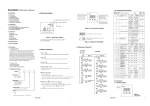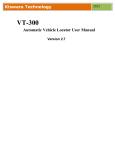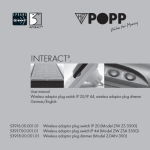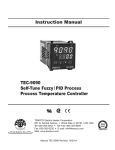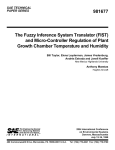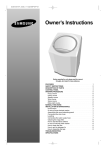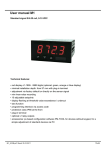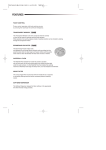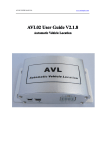Download User`s Manual - Future Design Controls
Transcript
User's Manual FDC-8130 Self-Tune Fuzzy / PID Process Temperature Controller 3. FRONT PANEL DESCRIPTION Model: FDC-8130 Instruction Manual °F Indicator CONTENTS 1. INTRODUCTION 7. CALIBRATION 2. NUMBERING SYSTEM 8. OPERATION 3. FRONT PANEL DESCRIPTION 9. ERROR MESSAGES 4. INPUT RANGE & ACCURACY 10. COMMON FAILURES 5. SPECIFICATIONS 11. T/C COLOR CODES C F PV °C Indicator Process Value Display ( 0.4" red LED) SV Setpoint Value Display ( 0.3" green LED) OUT1 OUT2 ALM1 ALM2 Control Outputs Alarm Outputs Scroll Key Down Key 6. INSTALLATION AT Return Key Up Key 1. INTRODUCTION This manual contains information for the installation and operation of the Future Design model FDC-8130 Fuzzy Logic micro-processor based controller. The Fuzzy Logic is an essential feature of this versatile controller. Although PID control has been widely accepted by industries, yet it is difficult for PID control to work with some sophistic systems efficiently, for examples systems of second order, long time-lag, various setpoints, various loads, etc. Because of disadvantage of controlling principles and fixed values of PID control, it is inefficient to control the systems with plenty of varieties, and the result is obviously frustrating for some systems. The Fuzzy Logic control can overcome the disadvantage of PID control, it controls the system in a efficient way by experiences it had before. The function of Fuzzy Logic is to adjust the PID values indirectly in order to making the manipulation output value MV adjusts flexibly and quickly adapt to various processes. By this way, it enables a process to reach its predetermined setpoint in the shortest time with minimum overshooting during tuning or external disturbance. Different from PID control with digital information, the Fuzzy Logic is a control with language information. FDC-8130 4. INPUT RANGE & ACCURACY PID control when properly tuned PID + F uzzy control PID + FUZZY CONTROL Temperature Setpoint SYSTEM + + Warm Up _ PID + Time (1) (2) (3) (4) (5) (6) (7) (8) 90-264VAC 20-32VAC/VDC Other (2) Signal Input 9 Configurable (Universal) Other (3) Range Code 1 9 Configurable Other (4) Control Mode 3 PID/ON-OFF Control (5) & (6) Output 1 & Output 2 Option 0 None 1 2 3 Relay rated 3A/240VAC 5A/240VAC resistive Resitive SSR Drive rated 20mA/24V 4-20mA linear, max. load 500 ohms (Module OM93-1) 4 0-20mA linear, max. load 500 ohms (Module OM93-2) 5 0-10V linear, min. impedance 500K ohms (Module OM93-3) 9 Other (7) Alarm Option (8) 0 None 2 9 Dual relay rated 2A/240VAC resistive Other Communication 0 None 1 RS-485 2 4-20mA retransmission 3 0-20mA retransmission 9 Input Type -50 Range (°C) to 999 °C Accuracy ±2 °C 1 K Chromel-Alumel -50 to 1370 °C ±2 °C 2 T Copper-Constantan -270 to 400 °C ±2 °C 3 E Chromel-Constantan -50 to 750 °C ±2 °C 4 B Pt30%RH/Pt6%RH 300 to 1800 °C ±3 °C 5 R Pt13%RH/Pt 0 to 1750 °C ±2 °C 6 S Pt10%RH/Pt 0 to 1750 °C ±2 °C 7 N Nicrosil-Nisil -50 to 1300 °C 8 RTD PT100 ohms (DIN) -200 to 400 °C 9 RTD PT100 ohms (JIS) -200 to 400 °C ±0.4 °C 10 Linear -10mV to 60mV -1999 to 9999 ±0.05% ±2 °C ±0.4 °C INPUT Load Disturbance (1) Power Input 5 Iron-Constantan 5. SPECIFICATIONS FUZZY 2. NUMBERING SYSTEM 5 9 J SV In addition, this instrument has functions of single stage ramp and dwell, auto-tuning and manual mode execution. Ease of use is also an essential feature with it. 4 Sensor 0 PV MV Model No.- IN Other Thermocouple (T/C): type J, K, T, E, B, R, S, N. RTD: PT100 ohm RTD ( DIN 43760/BS1904 or JIS ) Linear: -10 to 60mV, configurable input attenuation Range: User configurable, refer to Table above Accuracy: Refer to Table above Cold Junction Compensation: 0.1 °C / °C ambient typical Sensor Break Protection: Protection mode configurable External Resistance: 100 ohms max. Normal Mode Rejection: 60dB Common Mode Rejection: 120dB Sample Rate: 3 times / second CONTROL Proportion Band: 0-200 °C ( 0-360 °F ) Reset ( Integral ): 0-3600 seconds Rate ( Derivative ): 0-1000 seconds Ramp Rate: 0-200.0 °C / minute ( 0-360.0 °F / minute ) Dwell: 0-3600 minutes ON-OFF: With adjustable hysteresis ( 0-20% of SPAN ) Cycle Time: 0-120 seconds Control Action: Direct ( for cooling ) and reverse ( for heating ) POWER Rating: 90-264VAC, 50/60Hz Consumption: Less than 5VA ENVIRONMENTAL & PHYSICAL Operating Temperature: -10 to 50 °C Humidity: 0 to 90% RH ( non-codensing ) Insulation: 20M ohms min. ( 500 VDC ) Breakdown: AC2000V, 50 / 60Hz, 1 minute Vibration: 10-55Hz, amplitude 1mm Shock: 200 m / s2 (20g ) Net Weight: 260 grams Housing Materials: Poly-Carbonate Plastic Safety: UL, CSA, CE Page 1 7. CALIBRATION 6. INSTALLATION 6.1. DIMENSIONS & PANEL CUTOUT Note: Do not proceed through this section unless their is a genuine need to re-calibrate the controller. All previous calibration data will be lost. Do not attempt recalibration unless you have available appropriate calibration equipment. If calibration data is lost, you will need to return the controller to your supplier who may apply a charge for re-calibration . Prior to calibration ensure that all parameter settings are correct (input type, °C / °F, resolution, low range, high range). 3.62" 1. Remove sensor input wiring and connect a standard input simulator of the correct type to the controller input. Verify correct polarity. Set simulated signal to coincide with low process signal (e.g. zero degrees). 2. Use the Scroll Key until the " to 8.2.) " appears on the PV Display. (Refer 3. Use the Up and Down Keys until the SV Display represents the simulated input. 1.77" Panel Panel Cutout 4. Press the Return Key for at least 6 seconds ( maximum 16 seconds ), then release. This enters the low calibration figure into the controller's non-volatile memory. 2.55" Figure 6.1. Mounting Dimensions 6.2. WIRING DIAGRAM 5. Press and release the Scroll Key. " This indicates the high calibration point. FDC-8130 _ Control OUT 1 + 90-264 VAC Power Input C N.O C C N.O N.C AC1 AC2 6. Increase the simulated input signal to coincide with high process signal ( e.g. 100 degrees). Interface I/O 7. Use the Up and Down Keys until the SV Display represents the simulated high input. Alarm2 Com. 8. Press the Return Key for at least 6 seconds ( maximum 16 seconds ), then release. This enters the high calibration figure into the controller's non-volatile memory. Alarm2 N/O V _ + 11 12 13 14 15 16 17 18 19 20 + Control OUT 2 Tx1 C Tx2 N.O _ _ 1 2 3 4 5 6 7 8 9 10 + Alarm1 N/O Alarm1 Com. N.O " appears on the PV Display. B B RTD A 9. Turn power off the unit, remove all test wiring and replace sensor wiring (observing polarity). 8. OPERATION 8.1. KEYPAD OPERATION * With power on, it has to wait for 12 seconds to memorize the new values of parameters once it been changed. TOUCHKEYS FUNCTION AT Press for 6 seconds AT Press for 6 seconds Press and and Press for 6 seoncds AT AT DESCRIPTION Scroll Key Advance the index display to the desired position. Indexs advanced continuously and cyclically by pressing this keypad. Up Key Increases the parameter Down Key Decreases the parameter Return Key Resets the controller to its normal status. Also stops auto-tuning, output percentage monitoring and manual mode operation. Long Scroll Allows more parameters to be inspected or changed. Long Return 1. Executes auto-tuning function 2. Calibrates control when in calibration level Output Percentage Monitor Allows the set point display to indicate the control output value. Manual Mode Execution Allows the controller to enter the manual mode. Page 2 8.3. PARAMETER DESCRIPTION 8.2 FLOW CHART PROCESS VALUE DISPLAY SETPOINT VALUE DISPLAY Level 0 INDEX CODE SV Long (6 seconds) ** DEFAULT SETTING DESCRIPTION ADJUSTMENT RANGE Setpoint Value of Control * Low Limit to High Limit Value Undefined Alarm Setpoint Value * Low Limit to High Limit Value. (if or = 0, 1, 4 or 5) * 0 to 3600 minutes ( if = 12 or 13) * Low Limit minus set point to High Limit minus set point value ( if or = 2, 3, 6 to 11 ) 200 °C Ramp Rate for the process value to limit an abrupt change of process ( Soft Start) * 0 to 200.0 °C (360.0 °F) / minute ( if = 0 to 9 ) * 0 to 3600 unit / minute ( if = 10 ) Offset Value for Manual Reset ( if * 0 to 100% 0 °C / min. =0) 0.0% Offset shift for process value * -111 °C to 111 °C 0 °C Address Code for Digital Transmission * 0 - 31 : For Digital Transmission Level 1 0 Proportional Band of Output 1 * 0 to 200 °C ( set to 0 for on-off control ) 10 °C Proportional Band of Output 2 * 0 to 4.0 ( of PB ) 1.0 Dead Band * -100% to + 100% ( % of PB ) 5% Integral (Reset) Time * 0 to 3600 seconds 120 sec. Derivative (Rate) Time * 0 to 1000 seconds 30 sec. Local Mode 0: No control parameters can be changed 1: Control parameters can be changed 1 Parameter Selection ( allows selection of additional parameters to be accessible at level 0 security) Long (6 seconds) 0: None 1: 2: 3: , 4: , 5: 6: 7: 8: 9: 1 0: 1 1: , , , , , , 1 2: 1 3: 1 4: 1 5: , , , , , , , , 0 , Relay Pulsed Voltage Linear Volt/mA Proportional Cycle Time of Output 1 * 0 to 120 seconds 20 1 0 Proportional Cycle Time of Output 2 * 0 to 120 seconds Input Mode Selection 0: J type T/C 6: S type T/C 1: K type T/C 7: N type T/C 2: T type T/C 8: PT100DIN 3: E type T/C 9: PT100JIS 4: B type T/C 10: Linear Voltage or Current 5: R type T/C (Note: T/C - Close solder gap J3, RTD open J3) Level 2 Alarm Mode Selection 0: Process High Alarm 1: Process Low Alarm 2: Deviation High Alarm 3: Deviation Low Alarm 4: Inhibit Process High Alam 5 Inhibit Process Low Alarm 6: Inhibit Deviation High Alarm 7: Inhibit Deviation Low Alarm ( 12 & 13 only available with alarm 1) 8: Outband Alarm 9: Inband Alarm 10: Inhibit Outband Alarm 11: Inhibit Inband Alarm 12: Alarm Relay OFF as Dwell Time Out 13: Alarm Relay ON as Dwell Time Out Hysteresis of Alarm 1 * 0 to 20% of SPAN T/C 0 RTD 8 Linear 10 0 0.5% °C / °F Selection 0: °F , 1: °C 1 Resolution Selection 0: No Decimal Point 2: 2 Digit Decimal 1: 1 Digit Decimal 3: 3 Digit Decimal ( 2 & 3 may only be used for linear voltage or current = 10 ) 0 Control Action 0: Direct (Cooling) Action 1 1: Reverse (Heat) Action Error Protection Long (6 seconds) Level 3 The "return" key can be pressed at any time. This will prompt the display to return to the Process value/Setpoint value. Power Applied: 1. 2. Displayed for 4 seconds. (Software Version 3.4 or higher) LED test. All LED segments must be lit for 4 seconds. 3. Process value and setpoint indicated. 0: 1: 2: 3: 4: 5: 6: 7: Output 1 Output 2 Alarm 1 OFF OFF OFF OFF OFF ON ON OFF OFF ON OFF ON OFF OFF OFF OFF OFF ON ON OFF OFF ON OFF ON Alarm 2 OFF OFF OFF OFF ON ON ON ON 8: 9: 1 0: 11: 1 2: 1 3: 1 4: 15: Output 1 Output 2 Alarm 1 Alarm 2 OFF ON OFF OFF OFF ON ON OFF ON ON OFF OFF ON ON ON OFF OFF ON OFF ON OFF ON ON ON ON ON OFF ON ON ON ON ON Hysteresis for ON/OFF Control * 0 to 20% of SPAN 1 0.5% Low Limit of Range -50 °C High Limit of Range 1000 °C Low Calibration Figure 0 °C High Calibration Figure 800 °C NOTES: * Adjusting Range of the Parameter ** Factory settings. Process alarms are at fixed temperature points. Deviation alarms move with the setpoints value. Page 3 8.4. AUTOMATIC TUNING 8.7. RAMP & DWELL 1. Ensure that controller is correctly configured and installed. 2. Ensure Proportional Band 'Pb' is not set at '0'. 3. Press Return Key for at least 6 seconds (maximum 16 seconds). This initialises the Auto-tune function. (To abort auto-tuning procedure press Return Key and release). 4. The Decimal point in lower right hand corner of PV display flashes to indicate Auto-tune is in progress. Auto-tune is complete when the flashing stops. 5. Depending on the particular process, automatic tuning may take up to two hours. Processes with long time lags will take the longest to tune. Remember, while the display point flashes the controller is auto-tuning. NOTE: If an AT error ( ) occurs, the automatic tuning process is aborted due to the system operating in ON-OFF control (PB=0). The process will also be aborted if the setpoint is set to close to the process temperature or if there is insufficient capacity in the system to reach setpoint (e.g. inadequate heating power available). Upon completion of Auto-tune the new P.I.D. settings are automatically entered into the controller's non-volatile memory. 8.5. MANUAL P.I.D. ADJUSTMENT Whilst the auto-tuning function selects control settings which should prove satisfactory for the majority of processes, you may find it necessary to make adjustments to these arbitrary settings from time to time. This may be the case if some changes are made to the process or if you wish to 'finetune' the control settings. The FDC-8130 controller can be configured to act as either a fixed setpoint controller or as a single ramp controller on power up. This function enables the user to set a pre-determined ramp rate to allow the process to gradually reach setpoint temperature, thus producing a 'Soft Start' function. A dwell timer is incorporated within the FDC-8120 and the alarm relay can be configured to provide either a dwell function to be used in conjunction with the ramp function. The ramp rate is determined by the ' ' parameter which can be adjusted in the range 0 to 200.0 °C/minute. The ramp rate function is disabled when the ' ' parameter is set to 'o' The soak function is enabled by configuring the alarm output to act as a dwell timer. The parameter needs to be set to the value 12. The alarm contact will now operate as a timer contact, with the contact being closed at power up and opening after the elapsed time set at parameter . If the controller power supply or output is wired through the alarm contact, the controller will operate as a guaranteed soak controller. In the example below the Ramp Rate is set to 5°C/minute, =12 and =15(minutes). Power is applied at zero time and the process climbs at 5°C/minute to the setpoint of 125°C. Upon reaching setpoint, the dwell timer is activated and after the soak time of 15 minutes, the alarm contact will open, switching off the output. The process temperature will eventually fall at an undetermined rate. It is important that prior to making changes to the control settings that you record the current settings for future reference. Make slight changes to only one setting at a time and observe the results on the process. Because each of the settings interact with each other, it is easy to become confused with the results if you are not familiar with process control procedures. 150 TUNING GUIDE 125 °C Process Value 100 Proportional Band Symptom Solution 75 Slow Response Decrease PB Value 50 High Overshoot or Oscillations Increase PB Value 25 15 minutes ON Alarm Output Integral Time (Reset) Sympton Solution Slow Response Decrease Integral Time Instability or Oscillations Increase Integral Time OFF t(minutes) 0 10 20 30 40 50 60 70 80 90 Derivative Time (Rate) Symptom Solution Slow Response or Oscillations Decrease Deriv. Time High Overshoot Increase Deriv. Time The dwell function may be used to operate an external device such as a siren to alert when a soak time has been reached. need to be set to the value 13. The alarm contact will now operate as a timer contact, with the contact being open on the initial start up. The timer begins to count down once the setpoint temperature is reached. After the setting at has elapsed, the alarm contact closes. 8.6. MANUAL TUNING PROCEDURE Step 1: Adjust the integral and derivative values to 0. This inhibits the rate and reset action Step 2: Set an arbitrary value of proportional band and monitor the control results Step 3: If the original setting introduces a large process oscillation, then gradually increase the proportional band until steady cycling occurs. Record this proportional band value (Pc). Step 4: Measure the period of steady cycling 9. ERROR MESSAGES Symptom Cause (s) Solution(s) Sensor break error Replace RTD or sensor Use manual mode operation Process display beyond the low range setpoint Re-adjust value Process display beyond the high range setpoint Re-adjust value Analog hybrid module damage Replace module. Check for outside source of damage such as transient voltage spikes Record this value (Tc) in seconds Incorrect operation of auto tune procedure Prop. Band set to 0 Repeat procedure. Increase Prop. Band to a number larger than 0 Step 5: The Control Settings are determined as follows: Manual mode is not allowable for an ON-OFF control system Increase proportional band Check sum error, values in memory may have changed accidentally Check and reconfigure the control parameters PV PV(Process value) Tc TIME Proportional Band (PB) = 1.7 Pc Integral Time (TI) = 0.5 Tc Derivative Time (TD) = 0.125 Tc Page 4 10.0 COMMON FAILURE CAUSES ommon Failure Causes and Corrective Actions Symptom Probable Causes Corrective Actions - No power to instrument - Power supply defective - LED display or LED lamp defective - Related LED driver defective - Clean contact area on PCB - Replace keypads - Check power line connections - Replace power supply board - Replace LED display or LED lamp - Replace the related transistor or IC chip 4) Display Unstable - Analog portion or A-D converter defective - Thermocouple, RTD or sensor defective - Intermittent connection of sensor wiring - Replace related components or board - Check thermocouple, RTD or sensor - Check sensor wiring connections 5) Considerable error in temperature indication - Wrong sensor or thermocouple type, wrong input mode selected. - Analog portion of A-D converter defective - Check sensor or thermocouple type and if proper input mode was selected - Replace related components or board 6) Display goes in reverse direction ( counts down scale as process warms ) - Reversed input wiring of sensor - Check and correct 7) No heat or output - No heater power ( output ), incorrect output device used - Output device defective - Open fuse outside of the instrument - Check output wiring and output device - Replace output device - Replace output fuse 8) Heat or output stays on but indicator reads normal - Output device shorted, or power service shorted - Check and replace 9) Control abnormal or operation incorrect - CPU or EEPROM ( non-volatile memory ) defective. Key switch defective - Incorrect setup values - Check and replace - Read the setup procedure carefully 10) Display blinks; entered values change by themselves - Electromagnetic interference ( EMI ), or Radio Frequency interference ( RFI ) - EEPROM defective -Bad connection between PCB & keypads 1) Keypad no function 2) LED's will not light 3) Some segments of the display or LED lamps not lit or lit erroneously. - Suppress arcing contacts in system to eliminate high voltage spike sources. Separate sensor and controller wiring from " dirty " power lines, ground heaters - Replace EEPROM 11.0 T/C COLOR CODES hermocouple Cable Color Codes Thermocouple Type Cable Material British BS American ASTM German DIN French NFE T Copper ( Cu ) Constantan ( Cu-Ni ) + white blue * blue + blue red * blue + red brown * brown + yellow blue * blue J Iron ( Fe ) Constantan ( Cu- Ni ) + yellow blue * black + white red * black + red blue * blue + yellow black * black K Nickel-Chromium ( Ni-Cr ) Nickel-Aluminum ( Ni-Al ) + brown blue * red + yellow red * yellow + red green * green + yellow purple * yellow R S Pt-13%Rh,Pt Pt-10%Rh,Pt + white blue * green + black red * green + red white * white + yellow green * green B Pt-30%Rh Pt-6%Rh Use Copper Wire +grey red * grey +red grey * grey Use Copper Wire * Colour of overall sheath Page 5 Notes: Page 6 User's Manual FDC-8130 Process / Temperature Controller 7524 West 98th Place Bridgeview, IL 60455 Phone 888-751-5444 Fax 888-307-8014








